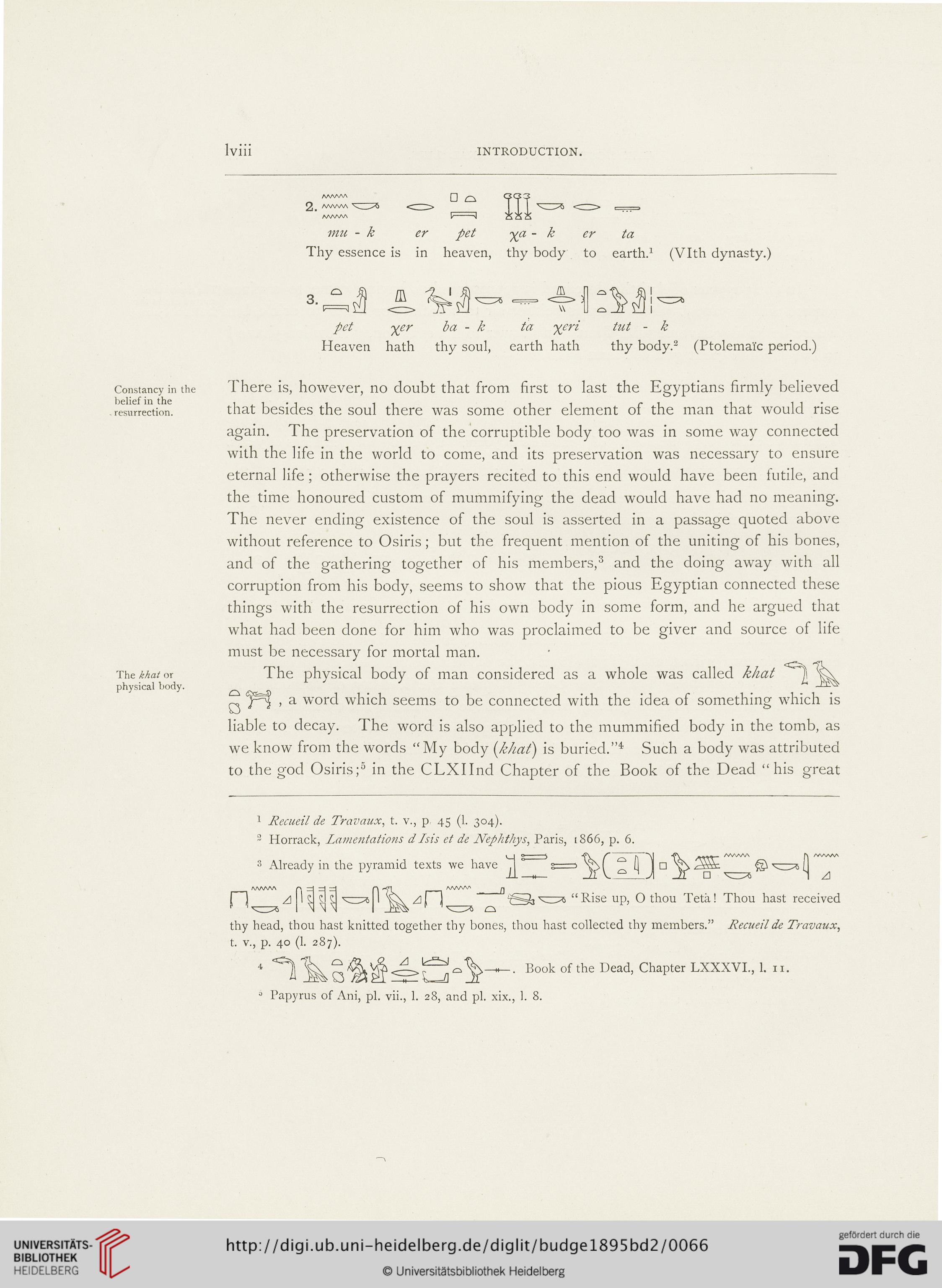lviii
INTRODUCTION.
2.
AAAAAA
AAAAAA
AAAAAA
- k er pet ya - k er ta
Thy essence is in heaven, thy body to earth.1
(Vlth dynasty.)
pet yer ba - k ta yeri tut - k
Heaven hath thy soul, earth hath thy body.2 (Ptolema'ic period.)
Constancy in the
belief in the
resnrrection.
The khat or
physical body.
There is, however, no doubt that from first to last the Egyptians firmly believed
that besides the soul there was some other element of the man that would rise
again. The preservation of the corruptible body too was in some way connected
with the life in the world to come, and its preservation was necessary to ensure
eternal life; otherwise the prayers recited to this end would have been futile, and
the time honoured custom of mummifying the dead would have had no meaning.
The never ending existence of the soul is asserted in a passage quoted above
without reference to Osiris; but the frequent mention of the uniting of his bones,
and of the gathering together of his members,1 * 3 and the doing away with all
corruption from his body, seems to show that the pious Egyptian connected these
things with the resurrection of his own body in some form, and he argued that
what had been done for him who was proclaimed to be giver and source of life
must be necessary for mortal man.
The physical body of man considered as a whole was called khat
^ <}25§ , a word which seems to be connected with the idea of something which is
liable to decay. The word is also applied to the mummified body in the tomb, as
we know from the words “My body (khat) is buriecl.”4 Such a body was attributea
to the gocl Osiris;5 in the CLXIInd Chapter of the Book of the Dead “ his great
1 Recueil de Travaux, t. v., p. 45 (1. 304).
3 Horrack, Lamentations dIsis et de Nephthys, Paris, 1866, p. 6.
3 Already in the pyramid texts we have ^ [j J
AAAAAA r\ —1 —] —1 r\ r<?1 _ AAAAAA ,
thy head, thou hast knitted together thy bones, thou hast collected thy members.” Recueil de Travaux,
t. v., p. 40 (1. 287).
T
‘Rise up, O thou Teta! Thou hast received
Book of the Dead, Chapter LXXXVI., 1. 11.
Papyrus of Ani, pl. vii., 1. 28, and pl. xix., 1. 8.
INTRODUCTION.
2.
AAAAAA
AAAAAA
AAAAAA
- k er pet ya - k er ta
Thy essence is in heaven, thy body to earth.1
(Vlth dynasty.)
pet yer ba - k ta yeri tut - k
Heaven hath thy soul, earth hath thy body.2 (Ptolema'ic period.)
Constancy in the
belief in the
resnrrection.
The khat or
physical body.
There is, however, no doubt that from first to last the Egyptians firmly believed
that besides the soul there was some other element of the man that would rise
again. The preservation of the corruptible body too was in some way connected
with the life in the world to come, and its preservation was necessary to ensure
eternal life; otherwise the prayers recited to this end would have been futile, and
the time honoured custom of mummifying the dead would have had no meaning.
The never ending existence of the soul is asserted in a passage quoted above
without reference to Osiris; but the frequent mention of the uniting of his bones,
and of the gathering together of his members,1 * 3 and the doing away with all
corruption from his body, seems to show that the pious Egyptian connected these
things with the resurrection of his own body in some form, and he argued that
what had been done for him who was proclaimed to be giver and source of life
must be necessary for mortal man.
The physical body of man considered as a whole was called khat
^ <}25§ , a word which seems to be connected with the idea of something which is
liable to decay. The word is also applied to the mummified body in the tomb, as
we know from the words “My body (khat) is buriecl.”4 Such a body was attributea
to the gocl Osiris;5 in the CLXIInd Chapter of the Book of the Dead “ his great
1 Recueil de Travaux, t. v., p. 45 (1. 304).
3 Horrack, Lamentations dIsis et de Nephthys, Paris, 1866, p. 6.
3 Already in the pyramid texts we have ^ [j J
AAAAAA r\ —1 —] —1 r\ r<?1 _ AAAAAA ,
thy head, thou hast knitted together thy bones, thou hast collected thy members.” Recueil de Travaux,
t. v., p. 40 (1. 287).
T
‘Rise up, O thou Teta! Thou hast received
Book of the Dead, Chapter LXXXVI., 1. 11.
Papyrus of Ani, pl. vii., 1. 28, and pl. xix., 1. 8.




